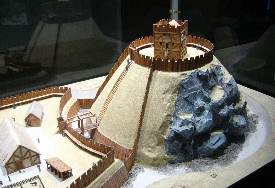Motte and Bailey castles
French Kings had gained a reputation for building castles. This was their way of coping with the constant attacks by Vikings from Scandinavia. French kings and noblemen took to protecting themselves in fortified buildings that were known as castellans - these served as private fortifications in which people and animals were protected from rape and pillage.Some of the Vikings eventually stayed in northern France and the Norsemen became the Normans. They had been impressed with the French castellans and adopted them; the most popular design was the motte and bailey.
 |
| Motte & Bailey |
In these early chateau, there was a fortified building (the chateau
or castle) on
top of a man-made hill (typically 50 to 120 feet high) called a
"motte". This served as a final
fighting place where soldiers would retreat if the rest of the
fortifications had been breached. The castle on the motte was reached
either by wooden stairs that could be destroyed if the castle
itself was attacked or by a 'flying bridge' that connected the
bailey to the castle. In the bailey (courtyard between the motte
and an outer wooden fence/wall), people and animals lived in
relative safety in times of peace as they were surrounded by a
large wooden fence that kept out attackers and wild animals.
The Bayeux Tapestry in France is an excellent source of information about the construction of
these mottes. The central tower used at Hastings was shipped from Normandy.
During the unsuccessful crusades, the design of the chateaux developed and became more sophisticated to repel the enemy. Attacks were made in four ways:
- missiles
- scaling walls
- starvation
- sappers - undermining the structure
The development of the chateau had to consider these forms of attack and designs and strategy were developed to survive these invaders.
Excellent resource: More information on Wikipedia.
[Next >> Chateaux Palaces]